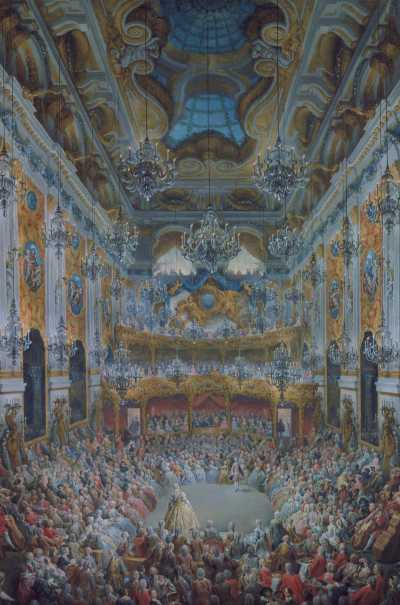15 - 19 June 2022, Burg Rothenfels am Main, Germany
The symposium originally planned for 2020 has been postponed to 2022 due to the pandemic. We plan to keep the same topic with the same speakers as much as possible. Very few had to cancel their contribution, a few others are currently still unsure whether they will be able to attend the conference in 2022. Therefore, we would now like to start a supplementary call for contributions. Contributions are welcome in all categories. Submissions that we cannot consider, will be put on a waiting list in case further speakers will not be able to come.
The ball, an almost universal social phenomenon whether in palaces, assembly halls or private houses, has a multi-tude of historical facets. As its name suggests, the ball is dedicated to the pleasure of dancing in various forms and styles. A special, festively designed form of public engagement, it is also a setting for demonstrations of princely power, staged rituals, pains¬takingly controlled etiquette and meticulous self-presentation. Last not least, political and social developments, evolutions or revolutions, are reflected in the ballrooms of Europe.
The main theme of the symposium is the phenomenon of the ball across five centuries from 1400 to 1900. The following aspects might serve as an inspiration for lectures, workshops and other contributions.
- Forms of its organisation, from royal court balls, dance events for a broader public to house balls: procedure, places times and occasions, ball regulations, ceremonies and rituals, etiquette, costumes and masques, ...
- Participants: dancers, musicians, dance masters, organisers, ...
- Dance forms and repertoire: collective versus couple dances, evolution of dance forms, dance codes, ...
- Social and political influences: the ball in the Enlightenment, the political use of balls, ...
- The question of identity: national and regional varieties, imitations, fashions and characteristics, ...
- Its function: visualisation of a social hierarchy, demonstrations of princely power, bourgeois self-presenta-tion, erotic encounters, liberation of everyday live, ...
- Interactions between ballroom and stage: ball scenes on stage, stage dance in the ballroom, ...
- The ball and women: the ball as a wedding market, emancipation in the ballroom, ...
- The ball in theoretical treatises: praise and criticism in contemporary writings, ...
- The ball mirrored by the arts: ball scenes in literature, in music and painting.
In addition to furthering scholarly debate, the symposium aims to present the state of dance research today to dancers and dance enthusiasts. The symposium will offer a wide range of activities from lectures, workshops, demonstrations, evening dancing and a festive ball with live music, plus an exhibition of books and music.
The organisers welcome contributions not previously published. Papers will be published in proceedings available at the symposium.
Contribution categories:

Lectures: Length: 25 min, followed by approx. 10 min discussion.
The lectures can also include short dance demonstrations. A publication of the papers is planned and will already be available at the symposium.
Honorarium: 200.- Euro
Research results poster: max. 60 x 80 cm
Our exhibition of posters also enables a concise presentation of research results. The poster space specified above allows you to present, explain and discuss your research in text and illustration.
Honorarium: 50.- Euro
Workshops: Length: 90 min
Thematic coupling with a lecture is possible. As they are carried out in groups of approx. 20 - 40 people, each workshop is held three times. Working materials for the participants should be prepared in advance.
Honorarium: 200.- Euro
Short performances: Length: 15 - 30 min
This category enables you to present your artistic conceptions to a specialist audience.
Honorarium: Exemption from the conference fee (ca. 220.- Euro) for all performers.
Conducting evening dance classes: Length: 100 - 120 min
A programme of relatively simple, easily learned social dances from the 15th to the 19th
century. Each class will be offered twice, with half the conference participants attending each time. A live music group will be available for one of the classes; recordings must be used for the second class. The dances taught in these classes will serve as the basis for the final ball programme.
Honorarium: 200.- Euro
Payments and expenses:
Speakers and participants in the short performances are exempted from the conference fee. Unfortunately, it is not possible, besides the honorarium mentioned in each case above, to grant any further allowances on costs of accommodation or travel.
Conference language:
Presentations, workshops and dance evenings may be held in either German or English.
Deadline for proposals: 1 June 2021
Please submit a short summary (max. 1 page) of your planned contribution by 1 June 2021 to Markus Lehner by mail, fax, or email (see below). The programme committee will make its selection by 1 August 2021.
 Programme committee:
Programme committee:
Prof. Carol G. Marsh (musicologist, editor of "Musical Theatre at the Court of Louis XIV")
Prof. Marie-Thérèse Mourey (professsor em. of German philology at the Sorbonne University, Paris, numerous publications in the field of historical dance)
Dr. Irene Brandenburg (musicologist and dance scholar, director of the "Derra de Moroda Dance Archives", University of Salzburg)
Dr. Anne Daye (dance scholar and Director of Education and Research of the Historical Dance Society, London)
Markus Lehner (Author of „A manual of sixteenth-century Italian dance steps“)
Organisation:
Markus Lehner, Dance & History e.V.
Mühlfelder Str. 18b
82211 Herrsching
Germany
Fax: +49-8152-981509
Email: info[at]historical-dance-symposium.org
Conference site:
For decades, Rothenfels castle has served as a conference center, welcoming historical dance events in particular, and is therefore well known to many dancers and dance groups. Since the first Rothenfels Dance Symposium took place there in 2004, it has been its host. The oldest part of the castle, dating from the 12th century, provides a lovely atmospheric setting. The castle is situated directly on the river Main between Würzburg and Frankfurt, 7 km north of Marktheidenfeld.
→ Download Call for Contributions
(source)
